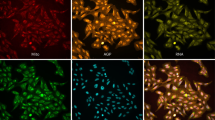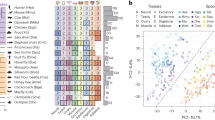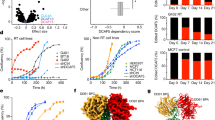Abstract
A key question in molecular genetics is why severe mutations often do not result in a detectably abnormal phenotype. This robustness was partially ascribed to redundant paralogs1,2 that may provide backup for one another in case of mutation. Mining mutant viability and mRNA expression data in Saccharomyces cerevisiae, we found that backup was provided predominantly by paralogs that are expressed dissimilarly in most growth conditions. We considered that this apparent inconsistency might be resolved by a transcriptional reprogramming mechanism that allows the intact paralog to rescue the organism upon mutation of its counterpart. We found that in wild-type cells, partial coregulation across growth conditions predicted the ability of paralogs to alter their transcription patterns and to provide backup for one another. Notably, the sets of regulatory motifs that controlled the paralogs with the most efficient backup activity deliberately overlapped only partially; paralogs with highly similar or dissimilar sets of motifs had suboptimal backup activity. Such an arrangement of partially shared regulatory motifs reconciles the differential expression of paralogs with their ability to back each other up.
This is a preview of subscription content, access via your institution
Access options
Subscribe to this journal
Receive 12 print issues and online access
$209.00 per year
only $17.42 per issue
Buy this article
- Purchase on Springer Link
- Instant access to full article PDF
Prices may be subject to local taxes which are calculated during checkout






Similar content being viewed by others
References
Conant, G.C. & Wagner, A. Duplicate genes and robustness to transient gene knock-downs in Caenorhabditis elegans. Proc. R. Soc. Lond. B Biol. Sci. 271, 89–96 (2004).
Gu, Z. et al. Role of duplicate genes in genetic robustness against null mutations. Nature 421, 63–66 (2003).
Nowak, M.A., Boerlijst, M.C., Cooke, J. & Smith, J.M. Evolution of genetic redundancy. Nature 388, 167–171 (1997).
Lynch, M., O'Hely, M., Walsh, B. & Force, A. The probability of preservation of a newly arisen gene duplicate. Genetics 159, 1789–1804 (2001).
Lynch, M. & Conery, J.S. The evolutionary fate and consequences of duplicate genes. Science 290, 1151–1155 (2000).
Force, A. et al. Preservation of duplicate genes by complementary, degenerative mutations. Genetics 151, 1531–1545 (1999).
Wagner, A. The role of population size, pleiotropy and fitness effects of mutations in the evolution of overlapping gene functions. Genetics 154, 1389–1401 (2000).
Gu, Z., Nicolae, D., Lu, H.H. & Li, W.H. Rapid divergence in expression between duplicate genes inferred from microarray data. Trends Genet. 18, 609–613 (2002).
Huh, W.K. et al. Global analysis of protein localization in budding yeast. Nature 425, 686–691 (2003).
Papp, B., Pal, C. & Hurst, L.D. Evolution of cis-regulatory elements in duplicated genes of yeast. Trends Genet. 19, 417–422 (2003).
van den Berg, M.A. et al. The two acetyl-coenzyme A synthetases of Saccharomyces cerevisiae differ with respect to kinetic properties and transcriptional regulation. J. Biol. Chem. 271, 28953–28959 (1996).
Kratzer, S. & Schuller, H.J. Transcriptional control of the yeast acetyl-CoA synthetase gene, ACS1, by the positive regulators CAT8 and ADR1 and the pleiotropic repressor UME6. Mol. Microbiol. 26, 631–641 (1997).
Hughes, T.R. et al. Functional discovery via a compendium of expression profiles. Cell 102, 109–126 (2000).
Jansen, R., Greenbaum, D. & Gerstein, M. Relating whole-genome expression data with protein-protein interactions. Genome Res. 12, 37–46 (2002).
Ge, H., Liu, Z., Church, G.M. & Vidal, M. Correlation between transcriptome and interactome mapping data from Saccharomyces cerevisiae. Nat. Genet. 29, 482–486 (2001).
Lynch, M. & Katju, V. The altered evolutionary trajectories of gene duplicates. Trends Genet. 20, 544–549 (2004).
Teichmann, S.A. & Babu, M.M. Gene regulatory network growth by duplication. Nat. Genet. 36, 492–496 (2004).
Kondrashov, F.A., Rogozin, I.B., Wolf, Y.I. & Koonin, E.V. Selection in the evolution of gene duplications. Genome Biol. 3, RESEARCH0008 (2002).
Papp, B., Pal, C. & Hurst, L.D. Metabolic network analysis of the causes and evolution of enzyme 'dispensability' in yeast. Nature 429, 661–664 (2004).
Kellis, M., Patterson, N., Endrizzi, M., Birren, B. & Lander, E.S. Sequencing and comparison of yeast species to identify genes and regulatory elements. Nature 423, 241–254 (2003).
Goldman, N. & Yang, Z. A codon-based model of nucleotide substitution for protein-coding DNA sequences. Mol. Biol. Evol. 11, 725–736 (1994).
Cavalcanti, A.R., Ferreira, R., Gu, Z. & Li, W.H. Patterns of gene duplication in Saccharomyces cerevisiae and Caenorhabditis elegans. J. Mol. Evol. 56, 28–37 (2003).
Steinmetz, L.M. et al. Systematic screen for human disease genes in yeast. Nat. Genet. 31, 400–404 (2002).
Harbison, C.T. et al. Transcriptional regulatory code of a eukaryotic genome. Nature 431, 99–104 (2004).
Pilpel, Y., Sudarsanam, P. & Church, G.M. Identifying regulatory networks by combinatorial analysis of promoter elements. Nat. Genet. 29, 153–159 (2001).
Kellis, M., Birren, B.W. & Lander, E.S. Proof and evolutionary analysis of ancient genome duplication in the yeast Saccharomyces cerevisiae. Nature 428, 617–624 (2004).
Lord, P.W., Stevens, R.D., Brass, A. & Goble, C.A. Investigating semantic similarity measures across the Gene Ontology: the relationship between sequence and annotation. Bioinformatics 19, 1275–1283 (2003).
Ozcan, S. Two different signals regulate repression and induction of gene expression by glucose. J. Biol. Chem. 277, 46993–46997 (2002).
McCammon, M.T. & McAlister-Henn, L. Multiple cellular consequences of isocitrate dehydrogenase isozyme dysfunction. Arch. Biochem. Biophys. 419, 222–233 (2003).
Garcia-Rodriguez, L.J. et al. Characterization of the chitin biosynthesis process as a compensatory mechanism in the fks1 mutant of Saccharomyces cerevisiae. FEBS Lett. 478, 84–88 (2000).
Acknowledgements
We thank all members of the laboratory of Y.P. for discussions; I. Pechersky for computational assistance; and Y. Garten, N. Barkai, J. Berman, B. Shilo, A.M. Dudley, I. Yanai, O. Man, S. Shen-Orr, D. Graur, D. Lancet, M. Levy and D. Artzi for critical review of the manuscript. Y.P. is an incumbent of the Aser Rothstein Career Development Chair in Genetic Diseases and is a Fellow of the Hurwitz Foundation for Complexity Sciences. We thank the Leo and Julia Forchheimer Center for Molecular Genetics and the Ben May Foundation for grant support. This paper is dedicated to the memory of I. Kafri.
Author information
Authors and Affiliations
Corresponding author
Ethics declarations
Competing interests
The authors declare no competing financial interests.
Supplementary information
Supplementary Fig. 1
The proportion of dispensable genes among genes that constitute a set of paralogous pairs with high functional similarity. (PDF 60 kb)
Supplementary Fig. 2
Effects of GO-annotated molecular function similarity on dispensability (and hence on backup potential) of paralogs. (PDF 80 kb)
Supplementary Fig. 3
Prevalence of predicted paralogous backup within and between organelles. (PDF 70 kb)
Supplementary Fig. 4
Dependence of protein-protein interactions on expression similarity and on Ks. (PDF 58 kb)
Supplementary Fig. 5
Negative correlation between expression similarity and protein function similarity of paralogs. (PDF 78 kb)
Supplementary Fig. 6
Regulatory motif content overlap, 'O' as a function of their divergence quantified by Ks. (PDF 44 kb)
Supplementary Fig. 7
Dependence of regulatory motif content similarity on Ks. (PDF 235 kb)
Supplementary Fig. 8
The proportion of paralogous isozymes within sets of paralogous gene pairs as a function of mean expression similarity and PCoR. (PDF 50 kb)
Supplementary Fig. 10
Effect of bin size in Fig 1 on results and statistics. (PDF 153 kb)
Supplementary Fig. 11
Linear fit for the viability and growth rate data of deletion mutants (as opposed to fraction of dispensable genes in each expression bin size) as a function of the mean expression similarity and PCoR between homologs. (PDF 489 kb)
Supplementary Fig. 12
Proportion of dispensable genes among the close paralogs (red), i.e. Ks <1, and duplicates arising from the whole genome duplication (blue) against the mean expression similarity and PCoR of the paralogous pairs. (PDF 65 kb)
Rights and permissions
About this article
Cite this article
Kafri, R., Bar-Even, A. & Pilpel, Y. Transcription control reprogramming in genetic backup circuits. Nat Genet 37, 295–299 (2005). https://doi.org/10.1038/ng1523
Received:
Accepted:
Published:
Issue Date:
DOI: https://doi.org/10.1038/ng1523
This article is cited by
-
The Fate of Duplicated Enzymes in Prokaryotes: The Case of Isomerases
Journal of Molecular Evolution (2023)
-
Dynamic evolution of small signalling peptide compensation in plant stem cell control
Nature Plants (2022)
-
Functional buffering via cell-specific gene expression promotes tissue homeostasis and cancer robustness
Scientific Reports (2022)
-
Evolution of buffering in a genetic circuit controlling plant stem cell proliferation
Nature Genetics (2019)
-
COR15B expression is affected by chloroplast functionality and its role in response to salt stress in Arabidopsis thaliana
Biologia plantarum (2014)



